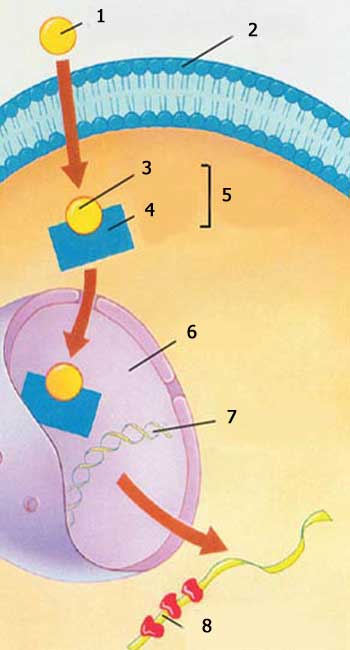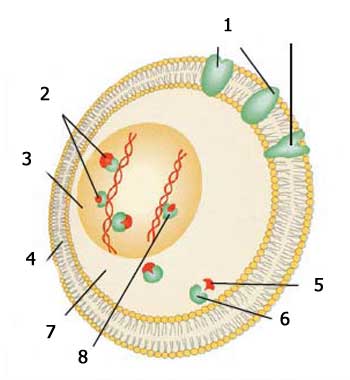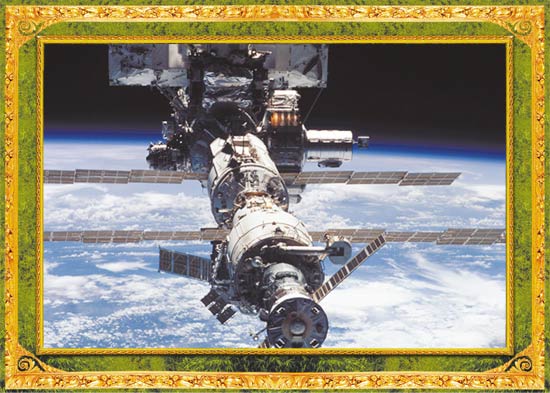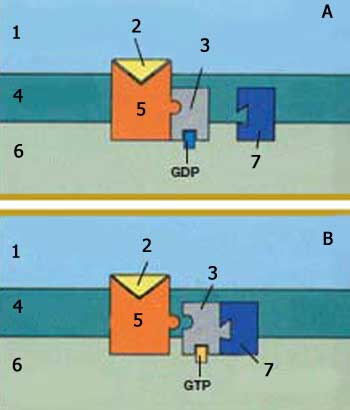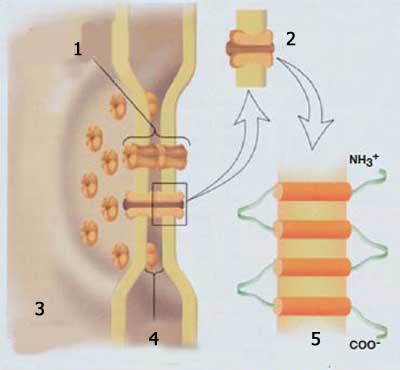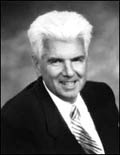Bigotry: The Dark Danger
The Miracle in the Cell Membrane

DOWNLOAD THE BOOK
CHAPTERS OF THE BOOK
- Foreword
- Introduction: The Consciousness Beyond Matter and The Col Lapse of Mechanism
- The Miniature Factories Comprising Our Bodies: The Cells
- The Cell's Complex Structure Can not Be Explained in Terms of Coincidence
- Superior Creation in The Structure of The Cell Membrane
- Complex Transportation Systems in The Cell Membrane
- The Selective Permeability of The Protein Channels in The Cell Membrane
- Selectivity in Nerve Cells
- Signal Selection in Traffic of Data Among Cells
- Selection in The Immune System's Cells
- Vital Selections in The Blood
- The Importance of The Creation in The Cell Membrane in Terms of Multi-Cellularity
- The Delicate Balance in Substances Selected in The Body
- The Cell Membrane Invalidates Claims of The Theory of Evolution
- Conclusion: Allah Pervades Everywhere With His Wisdom
< <
9 / total: 15
Signal Selection in Traffic of Data Among CellsEvery moment hundreds of messages literally rush from one part of our bodies to another. Your cells have been equipped with exceedingly complex recognition systems able to make the right selections from among all this information traffic and extracting relevant information. Codes belonging to the information are translated as the result of a chain chemical transformation.
Every moment hundreds of messages literally rush from one part of our bodies to another. Your cells have been equipped with exceedingly complex recognition systems able to make the right selections from among all this information traffic and extracting relevant information. Codes belonging to the information are translated as the result of a chain chemical transformation. The chemical messengers carrying these messages are liquids that allow different organs to correspond with one another.55 As a result of this connection, the cells of any living things behave as a whole and act as one in the face of sudden external changes or attacks. The French biologist Andre Lwoff, a Nobel Prize winner in physiology, has stated that every organism can remain alive only by means of the existing complex information: An organism is a system formed by inter-related structures and functions. It is formed by cells and cells are formed by molecules that are in a flawless cooperation. Each molecule should be aware of what the other is doing. It should be able to receive messages and act according to them.56 The way that cells are able to send and receive messages, recognize signals and unravel codes reveals organisms' abilities to act as a single unit. Coincidence cannot explain how the unconscious, unthinking cells work together in full cooperation and harmony, acting like a single entity with a single aim. This great harmony that results from the messages constantly exchanged by millions of cells is indicative of a superior Creation. The Communications Provided by HormonesIn many ways, the communications system among cells resembles the system used by human beings. For example, the receptors on cell membranes let them perceive the messages reaching them. Immediately beneath these receptors are structures like switchboards that decode the message reaching the cell. These receptors are located in a cell membrane just 1/100,000 of a millimeter thick, which entirely surrounds the cell. Each receptor, known as tyrosine kinase, consists of three main sections: the antenna, the body and the tail. The shape of that part of the antennae projecting outside the cell membrane resembles the dishes used to receive satellite broadcasts. In the same way that every dish is aimed to receive broadcasts from a specific satellite, so the messages carried by various hormone molecules are interpreted by different receptors. Hormonal messages from other cells make contact with the receptors in the cell membrane. However, every receptor has been created to perceive just one single "message." This special Creation prevents any message setting another receptor into action by mistake.
The hormone and receptor have been so ideally created for one another that almost all biological texts compared theirs to a lock-and-key relationship. Only the right key can open the lock; only the right receptor responds to the hormone being sent, which means nothing to other receptors. From the moment hormone reaches a cell, a system begins to work inside it. The incoming message reaches the cell's DNA by a special communication system; movement of the cell is provided by the help of this message. The hormone is transmitted at great speed to the cell nucleus. A most superior technology is employed during this communication process—an even greater miracle than the invention of a computer too small to be seen with the naked eye. Each cell is made up of unconscious protein molecules, and in your body there are 100 trillion cells, each of which possesses an advanced communications system. (For details, see Harun Yahya, The Miracle of Hormones.)
Hormones, secreted by special cells of the endocrine glands, spread throughout the body through the bloodstream. These hormones secreted into the body fluids are chemical substances that control the body's other cells. It is impossible for hormones, unaware even of the existence of other cells, to choose to assume the task of affecting them. These tasks, requiring a superior intellect, knowledge and consciousness, cannot be determined by tiny molecules. Neither can hormones know that the body has a given need and establish a way to affect the relevant cells accordingly… They simply perform the task set out for them flawlessly, within a perfectly established system, in full submission to Allah, Who gave them this duty and created them as components of this system. As stated earlier, great harmony exists between cells and hormones. Cells immediately understand the meaning of the messages that hormones bring. For example, when growth hormone arrives, the cells immediately recognize it and systematically implement such details as the rate at which various parts will grow. From that perspective, the cells are told when to produce hormones and in what quantities, to begin and halt production at the right times, and thus direct other hormones. This is clearly the result of an intellect. In the human body, as in every point in the universe, the artistry and knowledge of Allah, the Omniscient is revealed for all to see.
Strikingly, though hormones reach all the cells via the bloodstream, they have an effect on only their targeted ones. As the hormone moves in the extracellular fluid, certain cells recognize by means of the special receptors on the cells' surface. The chemical message then affects neighboring cells. In order for its message to be deciphered, the chemical messenger binds to the receptors, the most widespread of which are on the cell membrane. Almost all hormone receptors are large proteins, and every cell to be stimulated has between 2,000 and 100,000 receptors.57 But the number of receptors on the target cell is not fixed but can vary from day to day, even from minute to minute. Generally, when a hormone attaches to the target cell's receptor, this leads to a fall in the number of active receptors and to a reduction in the target tissue's sensitivity to the hormone. For that reason, either the receptors are activated at other times, or are re-activated, or else new receptors are produced by the mechanisms forming the cell protein. As you see, everything taking place at every stage is directed towards a particular end. It is self-contradictory to maintain that purposeful phenomena are the work of chance—just one of many matters that face Darwinists with an insoluble dilemma. In addition, cells generally possess different receptors for the same message. These receptors are generally specific to a single hormone, so that only the receptor that needs to be stimulated is stimulated, and the tissue that needs to be affected is affected.58 In the same way that only a key of a specific shape will open a lock, each receptor functions only when it binds to a molecule (ligand) of the right shape. These receptors select the different hormones to which they need to bind themselves, never making a mistake. However, there is no need of trial and error for the right lock and key to finally come together. Bear in mind that a single error could have fatal consequences, and you can better appreciate the perfect order in your body. This order of our Lord's is revealed in a verse from the Qur'an: ... He created everything and determined it most exactly. (Surat al-Furqan, 2)
Hormones' Effect on the ReceptorsA hormone creates its effect by activating target receptors in the cell membrane. When hormones attach themselves to these receptors, they cause changes in the receptor's protein structure. Some hormones have opening and closing effects, similar to the ion channels in the cell membrane. For example, they cause sodium and potassium channels to open and close. In this way, these ions alter the potential of muscle cell membranes and lead to a stimulating effect in some cells, and a calming effect in others.
The Speed of Signal Transmission
The speed at which hormones' complex system works is also astonishing. The messenger molecule's reaching the cell, its attachment to the cell membrane's antenna, initiation of the chemical reaction forming the bond between the hormone and antenna, transference of the hormonal message to the receptor antenna and the forwarding of that message to the cell nucleus—this all takes place exceedingly quickly. To achieve the necessary speed, many hormones form secondary messengers within the cell. For example, when a hormone in the G protein system reaches the cell surface, it attaches to a receptor and sends a signal to a G protein inside the cell membrane. That G protein, activated according to its type, either increases or reduces the effect of a string of enzymes. Adenylate cyclase is one instance; stimulating this enzyme leads to the production of periodic-AMP, a secondary messenger. A series of chemical reactions then take place, changing the forms of specific proteins within the cell, leading to other cellular reactions. When the level of the primary messengers falls, the G protein is inactivated and its effects come to an end. The cell uses this exceedingly complex signaling system to increase the efficiency and speed of message transmission. The arrival of a single messenger molecule initiates a series of reactions, reinforcing the original message and transmitting it onward. In addition, the delay between a signal arriving at a G protein and the cell's reaction is only a fraction of a second. By means of the G protein system, for example, light-sensitive retinal cells react to a single photon in just 1/100th of a second. In contrast, other cells may take up to 30 seconds to react to external signals.
The harmony between the messenger and the receptor, and the way that their communication with one another keeps us healthy at all times, are certainly a great miracle. Many trained chemists and biologists are unable to match the activities inside the cell, carried out on a scale too small to be seen with the naked eye. This undermines the claims of coincidence. Indeed, Darwinists have admitted their helplessness in the face of the complex system in hormones. The evolutionist writer Von Ditfurth expresses the perfection that he observes at the cellular level, with regard to the communications network among cells:
The communication among cells, touched on here in only very superficial terms, possesses a complexity that has occupied scientists for decades. Many volumes have been written on the subject. For that reason, the information obtained by scientists is substantial, but nevertheless superficial. There are many issues to consider here. How do the cells take and implement decisions? They assume responsibility for the protection of other cells they have never seen, so carefully as not to overlook the slightest detail. They are sufficiently farsighted to recognize danger. How did they acquire such sensitivity, measurement and timing? In addition, how is it possible for them to make other cells around them aware of what they need to know, to warn them, set them in operation, seek help and act on what other cells tell them in turn? It is a violation of reason and logic to claim that cells acquired all these abilities by blind coincidence. Furthermore, proteins bring the messages to the cells, receive messages and evaluate them. The gates and pumping systems that control entry to and departure from the cells are proteins too. Proteins accelerate chemical reactions. Whenever there is a need for any protein in the body, certain messengers—themselves proteins—know to find the right location in the body and forward the request for help in the correct way. The protein supplies this communication without becoming lost in the dark recesses of the body, without losing the message it carries, and without doing any harm anywhere. In other words, there is an enormous awareness of the duties to be carried out in every component of the system.
After a series of complex processes, the message reaching the cell nucleus generates a protein. In an astonishing way, the protein request reaches the right cells from among the body's 100 trillion cells, and the cell receiving the message immediately understands it, acts on it, and obtains a perfect result. We are not dealing with a community of human beings possessed of intellect, information and will power, but with minute unconscious entities, consisting of substances such as phosphorus, carbon and fat. There is no way that these molecules, invisible to the naked eye, can acquire such properties as communications, understanding and identification on their own. Like all molecules, they exhibit seemingly conscious behavior by acting in accord with the special inspiration given them by Allah.
Indeed, anyone who analyzes the molecular structure of the protein, DNA helixes and chromosomes would see that the phenomena of coincidence and chance could never bring such perfect structures into existence. This nonsense has hypnotized literally millions of people, whose reason and good conscience should prompt them to appreciate the marvels in Allah's Creation: "Your Lord creates and chooses whatever He wills. The choice is not theirs. Glory be to Allah! He is exalted above anything they associate with Him! Your Lord knows what their hearts conceal and what they divulge. He is Allah. There is no god but Him. Praise be to Him in this world and the Hereafter. Judgment belongs to Him. You will be returned to Him."(Surat al-Qasas, 68-70)
Footnotes55. Christiane Sinding, "Secrets of the Cell Language," Science et Vie, September 1993. 56. A. Lwoff, Z. Virus, Organismus Angewandte Chemie, No. 78, 1966, pp. 689-724. 57. Arthur C. Guyton, John E. Hall, Medical Physiology (Tıbbi Fizyoloji), Istanbul: Nobel Medical Book Houses, , 1996, pp. 928-929. 58. Christiane Sinding, "Linguistic Attainments of Cell Language," Science et Vie, September 1993. 59. Hoimar Von Dithfurt, Im Anfang War Der Wasserstoff ("Secret Night of the Dinosaurs"), Vol. 3 (pp.72-73 in Turkish edition).
|
|||||||||||||||||||||||||||||||||||||||||||||||||||||||
9 / total 15
You can read Harun Yahya's book The Miracle in the Cell Membrane online, share it on social networks such as Facebook and Twitter, download it to your computer, use it in your homework and theses, and publish, copy or reproduce it on your own web sites or blogs without paying any copyright fee, so long as you acknowledge this site as the reference.



